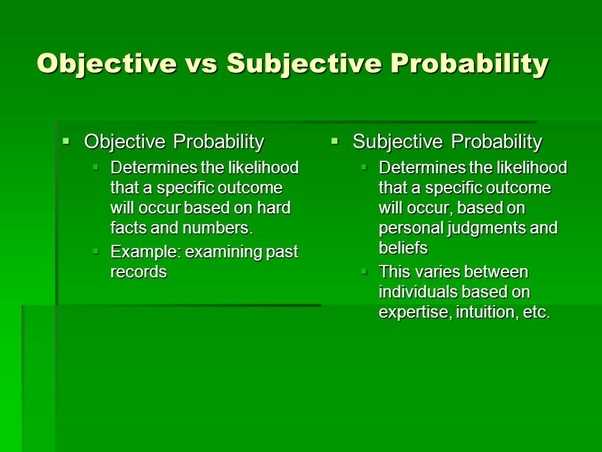Definition and Explanation of Objective Probability
Objective probability refers to the likelihood of an event occurring based on the inherent characteristics of the event itself, independent of any individual’s beliefs or opinions. It is a measure of the true probability of an event happening, unaffected by personal biases or subjective interpretations.
Objective probability is often contrasted with subjective probability, which is based on an individual’s personal beliefs, experiences, and perceptions. While subjective probability can vary from person to person, objective probability is considered to be the same for everyone.
Objective probability can be calculated using mathematical formulas and statistical analysis. It is often expressed as a decimal or a percentage, representing the likelihood of an event occurring on a scale from 0 to 1 or 0% to 100%. A probability of 0 means the event is impossible, while a probability of 1 means the event is certain.
Factors Influencing Objective Probability
Several factors can influence objective probability, including:
- Sample size: The larger the sample size, the more reliable the objective probability estimate is likely to be. A larger sample size reduces the impact of random variations and provides a more accurate representation of the true probability.
- Randomness: Objective probability assumes that events occur randomly and independently of each other. If there is a pattern or correlation between events, the objective probability may be affected.
- Context: The context in which an event occurs can influence its objective probability. For example, the probability of winning a game may be different depending on the skill level of the players or the rules of the game.
- Past data: Historical data can be used to estimate objective probabilities. By analyzing past events and their outcomes, statisticians can make predictions about future events.
| Advantages of Objective Probability | Disadvantages of Objective Probability |
|---|---|
| Provides an unbiased and objective measure of probability | Does not account for individual beliefs or subjective interpretations |
| Can be calculated using mathematical formulas and statistical analysis | May not accurately represent complex or unique situations |
| Used in decision-making processes, risk assessment, and predictive modeling | Relies on assumptions of randomness and independence |
Mechanisms and Factors Influencing Objective Probability
1. Randomness
2. Sample Size

The size of the sample or the number of observations taken into account is another important factor influencing objective probability. Generally, larger sample sizes provide more reliable and accurate estimates of the probability of an event. This is because larger samples reduce the impact of random variations and provide a more representative picture of the population.
3. Frequency of Occurrence
The frequency at which an event occurs also affects its objective probability. Events that occur more frequently are likely to have a higher objective probability compared to events that occur rarely. For example, the probability of getting heads in a coin toss is higher than the probability of winning the lottery.
4. Historical Data
Historical data can be used to analyze and determine objective probabilities. By examining past occurrences of similar events, patterns and trends can be identified, which can then be used to estimate the probability of future events. This is commonly used in fields such as finance, where historical stock market data is analyzed to predict future market trends.
5. Context and Conditions
The context and conditions in which an event occurs can also influence its objective probability. Factors such as weather conditions, location, and time of day can all impact the likelihood of certain events. For example, the probability of rain is higher in a tropical climate compared to a desert climate.

Emily Bibb simplifies finance through bestselling books and articles, bridging complex concepts for everyday understanding. Engaging audiences via social media, she shares insights for financial success. Active in seminars and philanthropy, Bibb aims to create a more financially informed society, driven by her passion for empowering others.
